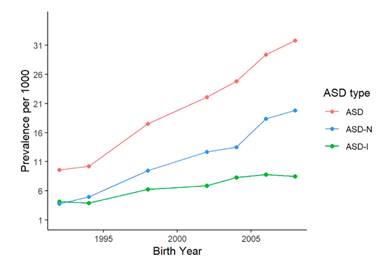Prevalence and Disparities in the Detection of Autism Without Intellectual Disability
Pediatrics | January 26, 2023
PDF – Full Article
Key Messages
 Abstract
Abstract
Background: Intellectual ability predicts functional outcomes for children with autism spectrum disorder (ASD). It is essential to classify ASD children with and without intellectual disability (ID) to aid etiological research, provide services, and inform evidence-based educational and health planning.
Methods: Using a cross-sectional study design, data from 2000 to 2016 active ASD surveillance among 8-year-olds residing in the New York-New Jersey Metropolitan Area were analyzed to determine ASD prevalence with and without ID. Multivariable Poisson regression models were used to identify trends for ASD with ID (ASD-I) and without ID (ASD-N).
Results: Overall, 4661 8-year-olds were identified with ASD. Those that were ASI-I were 1505 (32.3%) and 2764 (59.3%) were ASD-N. Males were 3794 (81.4%), 946 (20.3%) were Non-Hispanic Black (Black), 1230 (26.4%) were Hispanic, and 2114 (45.4%) were Non-Hispanic white (white). We observed 2-fold and 5-fold increases in the prevalence of ASD-I and ASD-N, respectively, from 2000-2016. Black children were 30% less likely to be identified with ASD-N compared with white children. Children residing in affluent areas were 80% more likely to be identified with ASD-N compared with children in underserved areas. A greater proportion of children with ASD-I resided in vulnerable areas compared with children with ASD-N. Males had higher prevalence compared with females regardless of ID status; however, male-to female ratios were slightly lower among ASD-I compared with ASD-N cases.
Conclusions: One-in-3 children with ASD had ID. Disparities in the identification of ASD without ID were observed among Black and Hispanic children as well as among children residing in underserved areas.